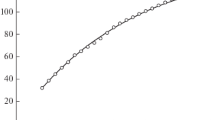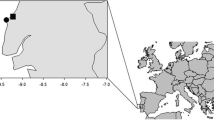Abstract
Based on a general equation of dynamics of the stationary age structure population, an equation relating the specific production of animals (C) and their life span (t p) was deduced: C =-lnp/(t p − t 0), where t p is age of animals, the relative number of which is (p) of the population number of the initial cohort; t 0 is age of animals of the younger age group in a studied sample or population. The resulting analytical model does not contradict the formerly published empirical relationship of specific production of animals to their life span and is corroborated by data on the correlation of these parameters in the mussel Mytilus galloprovincialis from the Black Sea, and other marine invertebrates.
Similar content being viewed by others
References
Alimov, A.F., Funktsional’naya ekologiya presnovodnykh dvustvorchatykh mollyuskov (Functional Ecology of Fresh-water Bivalves), Leningrad: Nauka, 1981.
Alimov, A.F., Vvedenie v produktsionnuyu gidrobiologiyu (Introduction to Production Hydrobiology), Leningrad: Gidrometeoizdat, 1989.
Buyanovsky, A.I., Prostranstvenno-vremennaya izmenchivost’ razmernogo sostava v populyatsiyakh dvustvorchatykh mollyuskov, morskikh ezhei i desyatinogikh rakoobraznykh (Space-time Variability of Size Structure in Populations of Bivalves, Sea Urchins and Decapods), Moscow: VNIRO, 2004.
Vinberg, G.G., Produktsiya populyatsii i soobschestv vodnykh organizmov i metody ee izucheniya (Production of Populations and Communities of Water Organisms and Methods of its Studying), Sverdlovsk: Ural Nauchn. Tsentr AN SSSR, 1985.
Zaika, V.E., Dependence of Productivity of Water Molluscs on Life Span, Okeanologiya, 1970, vol. 10, no. 4, pp. 702–708.
Zaika, V.E., Udel’naya produktsiya vodnykh bespozvonochnykh (Specific Production of Water Invertebrates), Kiev: Naukova dumka, 1972.
Zaika, V.E., Sravnitel’naya produktivnost’ gidrobiontov (Relative Productivity of Hydrobionts), Kiev: Naukova dumka, 1983.
Zaika, V.E. and Makarova, N.P., Theoretical Analysis of Production in Bakterioplankton, Produktsiya i pischevye svyazi v soobschestvakh planktonnykh organizmov (Production and Trophic Relations in Communities of Planktonic Organisms), Kiev: Naukova dumka, 1970, pp. 141–150.
Zaika, V.E. and Ostrovskaya, N.A., Growth rate, Life Span and Specific Production of Molluscs, Zhurn. obsch. biol., 1971, vol. 32, no. 3, pp. 317–322.
Zolotarev, V.N., Assessment of Life Span in Bivalve Populations, Zhurn. obsch. biol., 1982, vol. 43, no. 2, pp. 249–260.
Zolotarev, V.N., Sklerokhronologiya morskikh dvustvorchatykh mollyuskov (Sklerohronology of Marine Bivalves), Kiev: Naukova dumka, 1989.
Zolotarev, V.N. and Shurova, N.M., Life Span of Hydrobionts as an Ecological Indicator, Nauk. zap. Ternop. derzh. ped. univ. Ser. Biol. Spets. vipusk: Gidroekologia, 2001, no. 3 (14), pp. 52–53.
Manushin, I.E., Specific Production and the Maximum Life Span in Populations of Water Poikilothermic Animals, Mater. IV nauch. konf. Belomor. biol. st., 11–12 avgusta 1999 g. (Trans. IV Sci. Conf. White Sea. Biol. St. August 11–12, 1999), Moscow: Russkii Universitet, 1999, pp. 42–43.
Pogrebov, V.B. and Maksimovich, N.V., Production Parameters of Common Arctic Molluscs of White and Barents Seas in Conditions of Local Environmental Gradients, Biol. morya, 1990, no. 3, pp. 20–27.
Shurova, N.M. and Zolotarev, V.N., Seasonal Growth Layers in Shells of the Black Sea Mussel, Biol. morya, 1988, no. 1, pp. 18–22.
Shurova, N.M. and Stadnichenko, S.V., Production Properties of the Mussel Mytilus galloprovincialis from the Northwest Shelf of Black sea, Ekol. morya, 2001, no. 56, pp. 91–95.
Allen, J.A., Relation between Production and Biomass, J. Fish. Res. Board Can., 1971, vol. 28, pp. 1573–1581.
Ansell, A.D. and Lagardere, F., Observations on the Biology of Donax trunculus and D. vittatus at Ile d’Oléron (French Atlantic Coast), Mar. Biol., 1980, vol. 57, pp. 287–300.
Brey, T. Estimation of Annual P/B-ratio and Production of Marine Benthic Invertebrates from Length-frequency Data, Ophelia, 1986, Suppl. 4, pp. 45–54.
Brey, T., Arntz, W.E., Pauly, D., and Rumohr, H. Arctica (Cyprina) islandica in Kiel Bay (Western Baltic): Growth, Production and Ecological Significance, J. Exp. Mar. Biol. Ecol., 1990, vol. 136, pp. 217–235.
Brey, T. and Clarke, A., Population Dynamics of Marine Benthic Invertebrates in Antarctic and Subantarctic Environments: Are There Unique Adaptations? Antarct. Sci., 1993, vol. 5, no. 3, pp. 253–266.
Cardoso, R.S. and Veloso, V.G., Population Dynamics and Secondary Production of the Wedge Clam Donax hanleanus (Bivalvia: Donacidae) on a High-energy Subtropical Beach of Brazil, Mar. Biol., 2003, vol. 142, pp. 153–162.
Cusson, M. and Bourget, E., Global Patterns of Macro-invertebrate Production in Marine Benthic Habitats, Mar. Ecol. Progr. Ser., 2005, vol. 297, pp. 1–14.
Leveque, C., Durand, J.-R., and Ecoutin, J.-M., Relations entre le rapport P/B et la longévité des organisms, Cah. ORSTOM. Hydrobiol., 1977, vol. 11, pp. 17–31.
Lomovasky, B.J., Brey, T., Morriconi, E., and Calvo, J., Growth and Production of the Venerid Bivalve Eurhomalea exalbida in the Beagle Channel, Tierra del Fuego, J. Sea Res., 2002, vol. 48, pp. 209–216.
Luckinbill, L.S. and Foley, P. Experimental and Empirical Approaches in the Study of Ageing, Biogerontology, 2000, vol. 1, pp. 3–13.
McLaren, I.A., and Corkett, C.J., Singular, Mass-specific P/B Ratios Cannot be Used to Estimate Copepod Production, Can. J. Fish. Aquat. Sci., 1984, vol. 41, pp. 828–830.
McQuaid, C.D. and Lindsay, T.L., Effect of Wave Exposure on Growth and Mortality Rates of the Mussel Perna perna: Bottom-up Regulation of Intertidal Populations, Mar. Ecol. Progr. Ser., 2000, vol. 206, pp. 147–154.
Norte, A.G.C. del., Aspects of the Growth, Recruitment, Mortality and Reproduction of the Scallop Amusium pleuronectes (L.) in the Lingayen gulf, Philippines, Ophelia 1988, vol. 29, pp. 153–168.
Robertson, A.I., The Relationship between Annual Production: Biomass Ratios and Lifespans for Marine Macrobnenthos, Oecologia, 1979, vol. 38, pp. 193–202.
Urban, H.-J., Population Dynamics of the Bivalves Venus antique, Tagelus dombeii, and Ensis macha from Chile at 36 degree S, J. Shellfish Res., 1996, vol. 15, pp. 719–727.
Waters, T.F., The Turnover Ratio in Production Ecology of Freshwater Invertebrates, Amer. Nat., 1969, vol. 103, pp. 173–185.
Author information
Authors and Affiliations
Additional information
Original Russian Text © V.N. Zolotarev, S.V. Stadnichenko, 2006, published in Biologiya Morya.
Rights and permissions
About this article
Cite this article
Zolotarev, V.N., Stadnichenko, S.V. Dependence of specific production of marine invertebrates on their life span: An analytical model. Russ J Mar Biol 32, 236–240 (2006). https://doi.org/10.1134/S1063074006040055
Received:
Issue Date:
DOI: https://doi.org/10.1134/S1063074006040055




